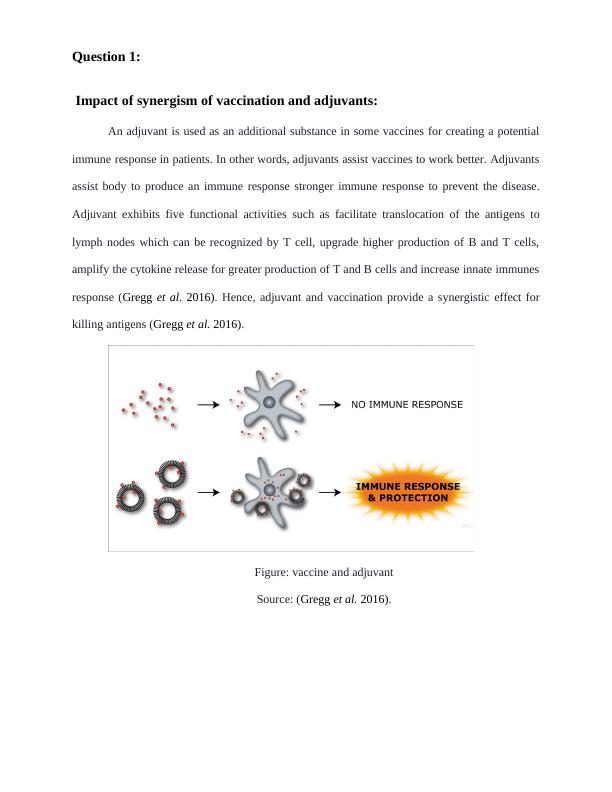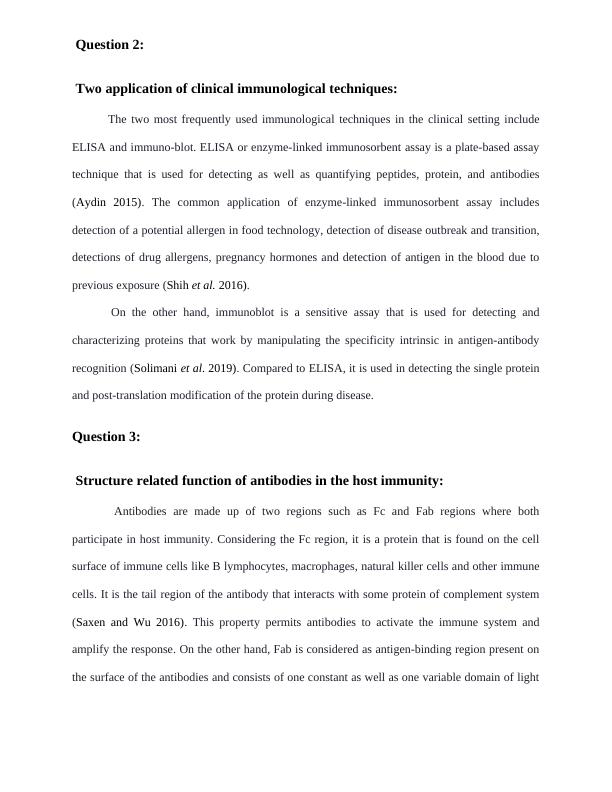Immunology Assignment | Doc
11 Pages2415 Words18 Views
Added on 2022-09-02
Immunology Assignment | Doc
Added on 2022-09-02
ShareRelated Documents
Running head: IMMUNOLOGY
IMMUNOLOGY
Name of the student:
Name of the university:
Author note
IMMUNOLOGY
Name of the student:
Name of the university:
Author note

Question 1:
Impact of synergism of vaccination and adjuvants:
An adjuvant is used as an additional substance in some vaccines for creating a potential
immune response in patients. In other words, adjuvants assist vaccines to work better. Adjuvants
assist body to produce an immune response stronger immune response to prevent the disease.
Adjuvant exhibits five functional activities such as facilitate translocation of the antigens to
lymph nodes which can be recognized by T cell, upgrade higher production of B and T cells,
amplify the cytokine release for greater production of T and B cells and increase innate immunes
response (Gregg et al. 2016). Hence, adjuvant and vaccination provide a synergistic effect for
killing antigens (Gregg et al. 2016).
Figure: vaccine and adjuvant
Source: (Gregg et al. 2016).
Impact of synergism of vaccination and adjuvants:
An adjuvant is used as an additional substance in some vaccines for creating a potential
immune response in patients. In other words, adjuvants assist vaccines to work better. Adjuvants
assist body to produce an immune response stronger immune response to prevent the disease.
Adjuvant exhibits five functional activities such as facilitate translocation of the antigens to
lymph nodes which can be recognized by T cell, upgrade higher production of B and T cells,
amplify the cytokine release for greater production of T and B cells and increase innate immunes
response (Gregg et al. 2016). Hence, adjuvant and vaccination provide a synergistic effect for
killing antigens (Gregg et al. 2016).
Figure: vaccine and adjuvant
Source: (Gregg et al. 2016).

Question 2:
Two application of clinical immunological techniques:
The two most frequently used immunological techniques in the clinical setting include
ELISA and immuno-blot. ELISA or enzyme-linked immunosorbent assay is a plate-based assay
technique that is used for detecting as well as quantifying peptides, protein, and antibodies
(Aydin 2015). The common application of enzyme-linked immunosorbent assay includes
detection of a potential allergen in food technology, detection of disease outbreak and transition,
detections of drug allergens, pregnancy hormones and detection of antigen in the blood due to
previous exposure (Shih et al. 2016).
On the other hand, immunoblot is a sensitive assay that is used for detecting and
characterizing proteins that work by manipulating the specificity intrinsic in antigen-antibody
recognition (Solimani et al. 2019). Compared to ELISA, it is used in detecting the single protein
and post-translation modification of the protein during disease.
Question 3:
Structure related function of antibodies in the host immunity:
Antibodies are made up of two regions such as Fc and Fab regions where both
participate in host immunity. Considering the Fc region, it is a protein that is found on the cell
surface of immune cells like B lymphocytes, macrophages, natural killer cells and other immune
cells. It is the tail region of the antibody that interacts with some protein of complement system
(Saxen and Wu 2016). This property permits antibodies to activate the immune system and
amplify the response. On the other hand, Fab is considered as antigen-binding region present on
the surface of the antibodies and consists of one constant as well as one variable domain of light
Two application of clinical immunological techniques:
The two most frequently used immunological techniques in the clinical setting include
ELISA and immuno-blot. ELISA or enzyme-linked immunosorbent assay is a plate-based assay
technique that is used for detecting as well as quantifying peptides, protein, and antibodies
(Aydin 2015). The common application of enzyme-linked immunosorbent assay includes
detection of a potential allergen in food technology, detection of disease outbreak and transition,
detections of drug allergens, pregnancy hormones and detection of antigen in the blood due to
previous exposure (Shih et al. 2016).
On the other hand, immunoblot is a sensitive assay that is used for detecting and
characterizing proteins that work by manipulating the specificity intrinsic in antigen-antibody
recognition (Solimani et al. 2019). Compared to ELISA, it is used in detecting the single protein
and post-translation modification of the protein during disease.
Question 3:
Structure related function of antibodies in the host immunity:
Antibodies are made up of two regions such as Fc and Fab regions where both
participate in host immunity. Considering the Fc region, it is a protein that is found on the cell
surface of immune cells like B lymphocytes, macrophages, natural killer cells and other immune
cells. It is the tail region of the antibody that interacts with some protein of complement system
(Saxen and Wu 2016). This property permits antibodies to activate the immune system and
amplify the response. On the other hand, Fab is considered as antigen-binding region present on
the surface of the antibodies and consists of one constant as well as one variable domain of light

and heavy chain. It is used to detect the antigen present in the blood, precipitate of antigens and
block the activate sites of antigens (Janda et al. 2016).
Figure: structure of anti body
Source: (Janda et al. 2016).
Question 4:
Difference between an antigen and an immunogen:
An antigen is considered as a molecule with the capability of binding to the antibodies or
cell surface receptors of B and T cells. On the other hand, immunogens are specific molecules or
antigens that can induce the immune response (Hancock, Haney and GilL 2016). An antigen can
be protein, polysaccharide, nucleic acid or lipid whereas immunogens are usually proteins or
large polysaccharides. In other words, while all immunogens are antigens, not all antigens are
immunogens (Hancock, Haney and GilL 2016).
Question 5:
Cytokines as therapeutic targets:
Cytokines are often played a crucial role in the pathogenesis of the inflammatory disease
and autoimmune disease. Cytokines trigger for the breakdown as well as subsequent events
block the activate sites of antigens (Janda et al. 2016).
Figure: structure of anti body
Source: (Janda et al. 2016).
Question 4:
Difference between an antigen and an immunogen:
An antigen is considered as a molecule with the capability of binding to the antibodies or
cell surface receptors of B and T cells. On the other hand, immunogens are specific molecules or
antigens that can induce the immune response (Hancock, Haney and GilL 2016). An antigen can
be protein, polysaccharide, nucleic acid or lipid whereas immunogens are usually proteins or
large polysaccharides. In other words, while all immunogens are antigens, not all antigens are
immunogens (Hancock, Haney and GilL 2016).
Question 5:
Cytokines as therapeutic targets:
Cytokines are often played a crucial role in the pathogenesis of the inflammatory disease
and autoimmune disease. Cytokines trigger for the breakdown as well as subsequent events

End of preview
Want to access all the pages? Upload your documents or become a member.
Related Documents
ELISA (Enzyme-Linked ImmunoSorbent Assay) for the immunization of mice with EAE equivalentlg...
|5
|1172
|334
ELISA Method for Estimation of Gliadin in Bread Sampleslg...
|8
|1888
|279
Enzyme-Linked Immunosorbent Assaylg...
|10
|2339
|261
Advancement in Immunassay Techniquelg...
|4
|797
|270
Serological Diagnosis of Dermatophytosislg...
|13
|1995
|18
Assignment on Biomedical Science- Immunologylg...
|12
|1872
|65
